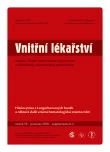Systemic mastocytosis
Authors:
M. Doubek 1; T. Kozák 2; V. Vašků 3; P. Szturz 1; M; Tichá 1; L. Křen 4
Authors‘ workplace:
Interní hematoonkologická klinika Lékařské fakulty MU a FN Brno, pracoviště Bohunice, přednosta prof. MUDr. Jiří Mayer, CSc.
1; Oddělení klinické hematologie FN Královské Vinohrady Praha, přednosta prim. doc. MUDr. Tomáš Kozák, CSc., MBA
2; 1. dermatovenerologická klinika Lékařské fakulty MU a FN u sv. Anny Brno, přednosta doc. MUDr. Vladimír Vašků, CSc.
3; Ústav patologie Lékařské fakulty MU a FN Brno, pracoviště Bohunice, přednosta doc. MUDr. Josef Feit, CSc.
4
Published in:
Vnitř Lék 2010; 56(Supplementum 2): 188-194
Category:
Langerhans cell histiocytosis and some other Hematology rare diseases
Overview
Systemic mastocytosis is a heterogenous disorder characterized by abnormal growth and accumulation of abnormal mast cells in one or more organs. Mast cells are derived from CD34+/KIT+ pluripotent hematopoietic cells in the bone marrow. Most adult mastocytosis patients carry gain-of-function c-kit receptor mutations, most commonly D816V in the tyrosine kinase domain. The clinical phenotype of systemic mastocytosis is variable. Many of patients are suffering from urticaria pigmentosa, followed by the flushing, cramping, abdominal pain, diarrhea, bone pain and hepatosplenomegaly. Most adult patients have systemic disease (a condition generally confirmed by bone marrow biopsy). The natural history of systemic mastocytosis ranges from indolent forms to very aggressive subtypes.
Key words:
diagnostics – KIT – management – masitinib – systemic mastocytosis
Sources
1. Aichberger KJ, Sperr WR, Gleixner KV et al. Treatment response to cladribine and dasatinib in rapidly progressing aggressive mastocytosis. Eur J Clin Invest 2008; 38: 869–873.
2. Amon U. Mastocytózy. In: Braun-Falco O,Plewig G, Wolff HH (eds). Dermatológia a venerológia. Martin: Osveta 2001: 1313–1319.
3. Brockow K, Scott LM, Worobec AS et al. Regression of urticaria pigmentosa in adult patients with systemic mastocytosis: correlation with clinical patterns of disease. Arch Dermatol 2002; 138: 785–790.
4. von Bubnoff N, Gorantla SH, Kancha RK et al. The systemic mastocytosis-specific activating cKit mutation D816V can be inhibited by tyrosine kinase inhibitor AMN107. Leukemia 2005; 19: 1670–1671.
5. Butterfield JH, Tefferi A, Kozuch GF. Successful treatment of systemic mastocytosis with high-dose interferon-alfa: long-term follow-up of a case. Leuk Res 2005; 29: 131–134.
6. Carter MC, Metcalfe DD. Biology of Mast Cells and the Mastocytosis Syndromes. In: Wolff K, Goldsmith LA, Katz SI et al (eds). Fitzpatrick’s Dermatology in General Medicine. New York: McGraw-Hill 2008: 1434–1443.
7. European Mastocytosis Support Network. 20. 7. 2010. Available from www.masocytosis.eu.
8. Garcia-Montero AC, Jara-Acevedo M, Teodosio C et al. KIT mutation in mast cells and other bone marrow hematopoietic cell lineages in systemic mast cell disorders: a prospective study of the Spanish Network on Mastocytosis (REMA) in a series of 113 patients. Blood 2006; 108: 2366–2372.
9. Kirshenbaum AS, Goff JP, Semere T et al. Demonstration that human mast cells arise from a progenitor cell population that is CD34(+), c-kit(+), and expresses aminopeptidase (CD13). Blood 1999; 94: 2333–2342.
10. Kitamura Y, Yokoyama M, Matsuda H et al. Spleen colony-forming cell as common precursor for tissue mast cells and granulocytes. Nature 1981; 291: 159–160.
11. Kozák T, Doubek M, Polívka J et al. Diagnostika a léčba systémové mastocytózy. XXIV. olomoucké hematologické dny. Sborník abstrakt 2010: abstract 1756.
12. Lennert K, Parwaresch MR. Mast cells and mast cell neoplasia: a review. Histopathology 1979; 3: 349–365.
13. Lim KH, Tefferi A, Laso TL et al. Systemic mastocytosis in 342 consecutive adults: survival studies and prognostic factors. Blood 2009; 113: 5727–5736.
14. Ma Y, Zeng S, Metcalfe DD et al. The c-KIT mutation causing human mastocytosis is resistant to STI571 and other KIT kinase inhibitors; kinases with enzymetic site mutations show different inhibitor sensitivity profiles than wild-type kinases and those with regulatory-type mutations. Blood 2002; 99: 1741–1744.
15. Metcalfe DD, Akin C. Mastocytosis: molecular mechanisms and clinical disease heterogenity. Leuk Res 2001; 25: 577–582.
16. Nagata H, Worobec AS, Oh CK et al. Identification of a point mutation in the catalytic domain of the protooncogene c-kit in peripheral blood mononuclear cells of patients who have mastocytosis with an associated hematologic disorder. Proc Natl Acad Sci USA 1995; 95: 10560–10564.
17. Nováková L, Kučera P. Systémová mastocytóza. Transfuze Hematol dnes 2009; 15: 31–38.
18. Pardanani A, Brockman SR, Páternoster SF et al. FIP1L1PDGFRA fusion: prevalence and clinicopathologic correlates in 89 consecutive patients with moderate to severe eosinophilia. Blood 2004; 104: 3038–3045.
19. Pardanani A, Elliott M, Reeder T et al. Imatinib for systemic mast-cell disease. Lancet 2003; 362: 535–536.
20. Pardanani A, Kimlinger T, Reeder T et al. Bone marrow mast cell immunophenotyping in adults with mast cell disease: a prospective study of 33 patients. Leuk Res 2004; 28: 777–783.
21. Péč M. Mastocytózy. Martin: Osveta 2004.
22. Purtill D, Cooney J, Sinniah R et al. Dasatinib therapy for systemic mastocytosis: four cases. Eur J Haematol 2008; 80: 456–458.
23. Swerdlow SH, Campo E, Harris NL et al. WHO classification of tumours of haematopoietic and lymphoid tissues. 4th ed. Lyon: IARC Press 2008.
24. Tharp MD. Mastocytosis. In: Bolognia JL, Jorizzo JL, Rapini RP (eds). Dermatology. New York: Mosby Elsevier 2009: 1845–1853.
25. Ustun C, Corless CL, Savage N et al. Chemotherapy and dasatinib induce long-term hematologic and molecular remission in systemic mastocytosis with acute myeloid leukemia with KIT D816V. Leuk Res 2009; 33: 735–741.
26. Valent P, Akin C, Sperr W et al. Diagnosis and treatment of systemic mastocytosis: state of the art. Br J Haematol 2003; 122: 695–717.
27. Valent P, Akin C, Sperr W et al. Mastocytosis: pathology, genetics, and current options for therapy. Leuk Lymphoma 2005; 46: 35–48.
28. Valent P, Spanblöchl E, Bankl HC et al. Kit ligand/mast cell growth factor-independent differentiation of mast cells in myelodysplasia and chronic myeloid leukemic blast crisis. Blood 1994; 84: 4322–4332.
Labels
Diabetology Endocrinology Internal medicineArticle was published in
Internal Medicine

2010 Issue Supplementum 2
Most read in this issue
- Hemophagocytic lymphohistiocytosis syndrome
- Erdheim-Chester disease in pictures
- Systemic mastocytosis
- Langerhans cell histiocytosis in children and adolescents
